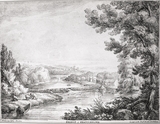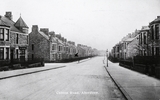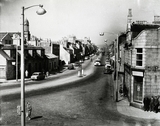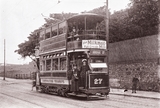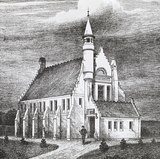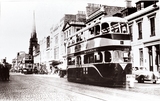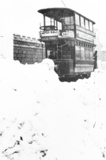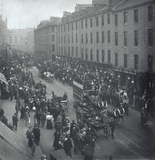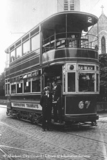|
Quick Search
|
Search Results
You searched for: More Like: 'Woodside electric tram'
155 items
items as
Bridge of Grandholme
160 An engraving showing Grandholm Bridge over the River Don from a drawing by James Giles. The inscription in the bottom right indicates that the engraving was printed at the Deaf and Dumb Institution.
This drawing likely looks west up the river and in the middle distance shows the Cruive Dikes, a complex of weirs and sluices across the River Don built for the purpose of fishing. Remains of these are located not far to the east of the modern Diamond Bridge.
Some information on the ownership and operation of the cruives is given in the book The Annals of Aberdeen (Volume II, 1818) by William Kennedy, on pages 207-209.
In the far distance is Grandholm Bridge. Aberdeen City Council's Historic Environment Record states that the bridge was built by the firm of Leys, Masson and Company in 1810 to improve access to its Granholm Works. It was a wooden bridge with a small lodge and was known locally as the "White Bridge."
The 1810 bridge was replaced by the present steel structure, built by the Motherwell Bridge Company, in 1922. Deeside Hydropathic
209 Deeside Hydropathic at Murtle, five miles to the west of Aberdeen City Centre, was built for the Rev Dr Alexander Stewart in 1899. He had founded a similar establishment in 1874 at Heathcot, Kincardinshire, and the growth of business there led to the selection of this new site close to Murtle Station on the Deeside Railway. It was also seen as a convenient centre for visiting the Deeside area. The extensive grounds included a croquet lawn, bowling green and tennis courts, while the Deeside Golf Club was only a mile away. The building itself had 92 bedrooms, there were Turkish, Russian, vapour, electric and spray baths. Since hydropathy was a medical treatment consisting of the external and internal application of water, the proximity of an artesian well supplying abundant pure water was also a feature. After the first World War, the building was sold and converted into Tor-Na-Dee Sanatorium in August 1918, specialising in the treatment of tuberculosis. More recently it has been used as a convalescent hospital, but it is now being re-developed for housing. Dr Stewart was born in 1835 in Coupar, Angus and studied at Glasgow University and did the medical course at Aberdeen University. At his death in 1909, he was Minister of John Street Congregational Church in Aberdeen, having been ordained there in 1864. Clifton Road, Aberdeen
213 This view from around 1910 shows Clifton Road looking south at its crossroads with Leslie Road and Hilton Street. Clifton Road runs north from Kittybrewster to Woodside, which was a separate burgh form Aberdeen until 1891. It was originally call Tanfield Road but was renamed in 1894. These mainly granite terraced houses were being built during the 1890s. On the left of the photo are the premises of A.M. Black, grocer. This corner shop, at 104 Clifton Road, was run by Miss Agnes M. Black and Miss Margaret Black between 1902 and 1940. Their home was at 1 Leslie Road. The windows contain adverts for Rowntrees Chocolates and Fry's Pure Cocoa. Union Street
284 Union Street looking west. The photograph shows the Music Hall and a busy street scene. There are many pedestrians and people can be seen riding bicycles. A tram, number 30, to Castle Street is in the background.
Ornate street lamps can be seen on the left. Tram lines divide the cobbled streets and power lines are visible overhead. Great Northern Road, Woodside
287 Today Woodside is a busy and thriving community with a dual carriageway and railway running through its heart. Modes of transport and services have changed radically over the past two hundred years but due to its location Woodside has always been part of a wider network and this has helped to drive industry and increase travel. The General Post Office
317 The Staff and guests outside The General Post Office, Crown Street. The building was opened in 1907. W.T. Oldrieve with J. Cumming Wyness (designer). Note the tram lines in the street. Horse-drawn tram and mechanical tram, Union Street
353 Horse-drawn tram and mechanical tram (Mannofield and Castle Street) side by side in Union Street No. 27 Tram
392 Many thanks to Silver City Vault users Dr Mike Mitchell and Brian Kennedy for providing us with information on this photo. It shows the no. 27 tram on Victoria Road with the wall of Balnagask House in the background.
The Balnagask Mains farm is partially visible to the left of the tram. The St. Fittick's Road terminus of the Torry Route is located further along Victoria Road.
The female conductor indicates the photo was taken during the Great War. The tram waits to depart for Bridge Street. Market Day at Castle Street
420 Market Day at Castle Street looking towards the Salvation Army Citadel. Note the row of cabs opposite the Town House and the open topped tram. Children's library, Woodside
421 The Children's section downstairs in Woodside Library, Clifton Road. The No2. Woodside Tram, 1900
430 The No2. Woodside Tram. Anderson Road, Aberdeen 1900.
A group of Aberdeen businessmen formed the Aberdeen District Tramways Company in 1871 and proposed a number of tram routes to run within Aberdeen. This was the beginning of the use of horse drawn trams within the city and a regular tram service started to run from St. Nicholas Street to Woodside.
The Aberdeen Corporation purchased the District Tramways in 1898 and started to electrify the tram routes and the first route to be electrified was the Woodside line in December 1899. The trams were a popular and convenient mode of travel and the tramways competed with the railways by providing a similar suburban service.
By the 1950's plans were afoot to replace all of the trams with buses as Aberdeen Transport Committee decided that a modern fleet of buses could provide quicker and more regular services at cheaper running costs. The last tram to Woodside ran in 1955.
Anderson Library, Clifton Road, Woodside
439 Engraving of the Anderson Library, Clifton Road, Woodside. The library was built by Sir John Anderson. The Architect was Arthur Clyne. c.1883. The Barracks, Woodside
440 A factory worker had a hard working day with the day beginning as early as 5.30 same days, wages were also very poor. Woodside works built housing across the field from the mill to house apprentices. The building was known as the Barracks and also Persley Castle. It later served as a residential care home. Electric tramcar on Union Street
522 The end of Aberdeen's trams, 3rd. May 1958, with 2 trams on Union Street. Castle Street tram
524 The Castle Street tram, car no. 15, photographed in front of Queen's Cross Church. This is a closed-top deck tram, alterations from open-top deck trams starting in 1906. Aberdeen Corporation Mannofield tram
525 Aberdeen Corporation Mannofield tram, car no.19 taken in 1901. Aberdeen Corporation Castle Street tram stuck in the great snowstorm of 1908
565 Aberdeen Corporation Castle Street tram stuck in the great snowstorm of 1908 Union Street from Holburn Junction
725 Union Street looking east from Holburn Junction. Note the tram car in the foreground and the railings round the house basements on the left of the photograph. A parade of trams along Union Street
734 Correspondent Dr Mike Mitchell informs us that this is the celebration of the take over of the Aberdeen District Tramways by Aberdeen Corporation in 1898. The photo was probably taken by Councillor Alexander Wilkie, who is recorded as having gone across the road from the Town House to photograph the parade, and was a Woodside based professional photographer. Congregational Church, Woodside
822 Congregational Church, Woodside. This is the oldest church in Woodside and had its origin in the early 19th Century, when the people of the district had no place of worship nearer than Oldmachar Cathedral. A subscription list was issued in November 1818, and within a month enough money had been raised to permit building operations to begin. A small thatch-roofed building was erected on the site of the present Congregational Church and although there is no record of the opening services, they must have taken place near the end of 1819. the building was known as the Cotton Chapel. Sea Beach Tram
871 Photograph of a tram going to the Sea Beach. Correspondent Dr Mike Mitchell comments that tram 67 was built in Dee Village workshops - then the main tramcar works - in 1919 as an unemployment relief measure. The construction used parts from an ex-horse car conversion of the same number. It was delivered in December 1919 and ran until 1953/54. |



